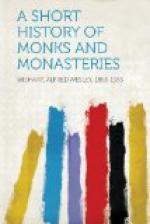1. The temptation is strong to claim a fraud, especially because the same witnesses who testify to the truth of the tale, also relate such monstrous, incredible stories, that one is almost forced to doubt either their integrity or their sanity. But there is no evidence in support of so serious an indictment. After showing that signs and portents attend every crisis in history, Mrs. Oliphant says: “Every great spiritual awakening has been accompanied by phenomena quite incomprehensible, which none but the vulgar mind can attribute to trickery and imposture;” but still she herself remains in doubt about the whole story.
2. Although Mosheim uses the term “fraud,” it would seem that he means rather the irresponsible self-infliction of the wounds. He says: “As he [Francis] was a most superstitious and fanatical mortal, it is undoubtedly evident that he imprinted on himself the holy wounds. Paul’s words, ‘I bear in my body the marks of the Lord Jesus,’ may have suggested the idea of the fraud.” The notion certainly prevailed that Francis was a sort of second Christ, and a book was circulated showing how he might be compared to Christ in forty particulars. There are many things in his biography which, if true, indicate that Francis yearned to imitate literally the experiences of his Lord.
3. Numerous experiments, conducted by scientific men, have established the fact that red marks, swellings, blisters, bleeding and wounds have been produced by mental suggestion. Bjoernstrom, in his work on “Hypnotism,” after recounting various experiments showing the effect of the imagination on the body, says, respecting the stigmata of the Middle Ages: “Such marks can be produced by hypnotism without deceit and without the miracles of the higher powers.” Prof. Fisher declares: “There is no room for the suspicion of deceit. The idea of a strange physical effect of an abnormal state is more plausible.” Trench thinks this is a reasonable view in the case of a man like Francis, “with a temperament so irrepressible, of an organization so delicate, permeated through and through with the anguish of the Lord’s sufferings, passionately and continually dwelling on the one circumstance of his crucifixion.” But others, despairing of any rational solution, cut the Gordian knot and declare that “the kindest thing to think about Francis is that he was crazy.”
4. Roman Catholics naturally reject all explanations that exclude the supernatural, for, as Father Candide Chalippe affirms: “Catholics ought to be cautious in adopting anything coming from heretics; their opinions are almost always contagious.” He therefore holds fast to the miracles in the lives of the saints, not only because he accepts the evidence, but because he believes these wonderful stories “add great resplendency to the merits of the saints, and, consequently, give great weight to the example they afford us.”
It is altogether probable that each one will continue to view the whole affair as his predispositions and religious convictions direct; some unconvinced by traditionary evidence and undismayed by charges of heresy; others devoutly accepting every monkish miracle and marveling at the obstinacy of unbelief.




